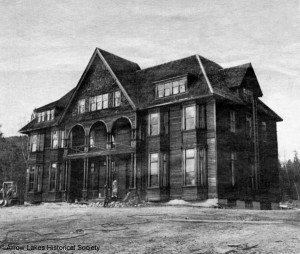Written by Rosemarie Parent from the Arrow Lakes Historical Society publications and archival information.

St. Leon Hot Springs was one of several hot springs that were developed in the early days because of its setting and beautiful sandy beach. Mike Grady, owner of the springs, advertised in 1898 that baths were free but accommodations were $1.25 per day, which was relatively expensive for those days. The lodgings were obviously for men only because they were fairly crude, but lumberjacks and miners were used to such conditions.
Even at this time, Mike was trying to persuade the CPR to develop this beautiful site into a Banff-like operation, but without success. This was likely due to the company’s association with Halcyon Hot Springs, which did not encourage competition.
In 1904, Mike sold his Standard Mine in the Slocan and took the money to build his dream hotel on the delta of St. Leon and Halfway Creeks. The entire hotel was constructed of clear lumber, mostly cedar. Even the pools, which were centered near the lobby, were made of wood, with the ladies’ pool directly above the men’s. The moldings and banisters were wooden with no paint or varnish used anywhere. Molly and Louise Smith, Mike’s nieces scrubbed this woodwork clean every day.
The water was piped with some difficulty, almost two miles from the source. By the time it got to the hotel, it was only tepid. Mike fashioned a series of coils in a large ditch for the water to run through and be reheated. A cordwood fire burned continuously there summer and winter. It was not pretty but it was effective. The hotel attracted many visitors and the business prospered.

Tourism increased each year and a plan was promoted for the Arrow Lakes to take advantage of the hot springs potential for greater development. The CPR announced in 1910 that the Bonnington, the largest sternwheeler in the southern interior, was to be built in Nakusp shipyard starting that fall. It was completed in 1911 with much fanfare, sports events and a dance in the evening. However, because St. Leon did not have a wharf like Halcyon Hot Springs did, the loading and unloading of passengers and freight was hindered. The boats had to land on the beach instead.
Both Halcyon and St. Leon were deeply affected by the war. Patronage almost stopped at times. Prohibition in 1916 also discouraged many faithful customers from making the long trip, especially off-season. Finally the hotel was closed and the hot water was disconnected, opening only for a month or two in the summer. Mike was persuaded to survey a portion of his 230 acres into lots that could be sold for cottages and tents. By 1915, there were ten little houses built and tenting became very popular.
Over the years, John Olson of Galena Bay visited Mike whenever possible to make sure he was all right. About 1940, he and son Peter decided that they would take him to the Olson home to look after him, because he could no longer be on his own. Two years later, he went to a home for seniors in Kamloops, where he died in 144.
Mike sold the springs in 1933 to Grace Rixon of Revelstoke and then in 1945, she sold to Ed Gates. He changed the name to Gates of St. Leon and tried to develop the springs into a spa. In those days, Ed wanted the springs to be reachable by boat only but businessmen in Nakusp were convinced a highway was necessary. The CPR was determined to take the SS Minto out of service, leaving Halcyon and St. Leon stranded without access to food, goods, patrons and services. This was accomplished on April 24, 1954 and from then on the hotels could only be reached by small pleasure boats. After a few years, it because impossible to keep the facility going and Ed closed his 28-room hotel and sold off the contents at a sale in Nakusp.
When talk of a dam on the Arrow Lakes became serious in the 1950s and 1960s, a recommended Low Arrow dam would have meant little damage and minimum flooding on the Arrow Lakes. However, this was not to be. A High Arrow dam was decided upon and changed the lakes forever. This would have completely covered the St. Leon Hotel. Ed and BC Hydro had been negotiation a settlement, when on November 9, 1968, a mysterious fire left the building in ashes.
